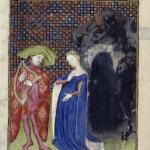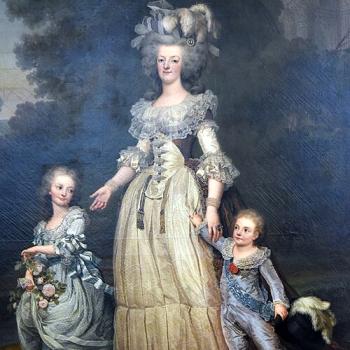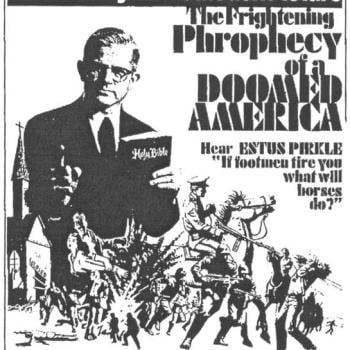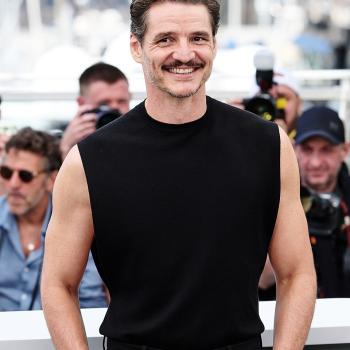
Source: Flickr User Gage Skidmore
License: Creative Commons
Adapted from a Neil Gaiman short story, the John Cameron Mitchell-directed How to Talk to Girls at Parties poses as a teen movie. The promotional poster shows Elle Fanning cuddled up to cut-off t-shirt-wearing Alex Sharp, the background an eclectic mix of Barbarella-influenced (1968) partygoers and punks. Or maybe I should’ve known better. Gaiman isn’t exactly known for working in the grand tradition of American Pie (1999) and Superbad (2007). In any case, the title got us—my wife and me. About halfway through I turned to her and asked unbelievingly why the movie had lied to us. More perceptive than I am as usual, she shot back: “it makes perfect sense. It’s a trap.”
Admiral Ackbar joke aside, she’s right—and in more ways than one. As best I can discern, this movie wants to be about the conflict between individuality and conformity, taking punk at its origin as a test case. In reality, both its style and story untether from that foundation; what we get is If…. (1968) if it followed the late Boomers and early Gen X to adulthood. How to Talk to Girls is a horribly honest movie, though I don’t think it means to be so.
A montage accompanied by punk music follows Enn (Alex Sharp) as he cycles around London slapping his homemade “virus” stickers on poles and taunting squares. The tone is manic with a sped-up framerate and rapid cuts. Along the way he picks up his two friends Vic (Abraham Lewis), the most suave of the group, and John (Ethan Lawrence), the classic teen movie chubby sidekick (paging the only Jonah Hill I choose to remember). They go to a show overseen by Boadicea (Nicole Kidman) a fashion designer and local punk queen, who has her eye on a record label scout in the audience. Tight shots lend the show a cramped feel, cutting back and forth between the sweating, screaming crowd and a dyed-haired teen boy in a dress with a dog chain around his neck. This singer crosses Boadicea (perhaps by stage diving into the scout, though the dim lighting makes it hard to tell. I choose to believe he’s guilty of some sexual indiscretion), who slaps him, eliciting a screech of “you remind me of my mom!” “Good!” she replies.
So much for punk.
All this is a set-up so the boys can overhear where the afterparty is, a bit of info otherwise surrounded by banter about Enn’s friends’ willingness to take advantage of women and mock him for refusing to do so (“Tracy the slag?” “[No], Tracy the magnanimous”). This is not, however, the party they are looking for. Knocking on the door, the gang is greeted by a woman in a full latex jumpsuit, hair tied up like a German-retread of Thing #1 [think Magenta and Riff Raff at the end of The Rocky Horror Picture Show (1975)]. Here the lights are not dim, rather spot lighting marks out more of these American-accented fetishists, whose hands slide in and out of strange vulva-like screens. “Jackpot,” Vic says. “They must be from California.” Sex, sex, sex—the punk ethos. But they’re not in Croydon anymore.
This is where things get, uh, “proper strange.” Vic finds himself getting probed with a rubber glove by a female alien who bifurcates into a man and a woman when she really “gets into it.” John dances to trance music among a gaggle of Yayoi Kusama enthusiasts. Enn, however, finds Zan (Elle Fanning), who decides (invoking some arcane alien rule) to run off with him to learn about Earth and its people (that is, before the aliens consume them in “the great eating.” Sounds nice).
As far as introductions go, this isn’t all that bad. We proceed into some rom com of manners, in which Zan’s literal mind learns the subtleties of earthly youth culture (she wants to “experience punk” especially). Enn’s friends are in disbelief that he’s found a girlfriend, while his mom’s just glad he’s dating someone who “seems nice.” We learn that Enn’s dad ran off, though, because he was a Leftist and jazz musician, his son admires him nonetheless. We’ve got some worthwhile binaries and conflicts here. Throw in some more fast-paced punk montage about the two falling for each other and, well, I found myself interested in what would happen next.
Unfortunately, that promise remains unfulfilled. The 102 minutes goes on for what feels like forever as the film clutters more and more with bizarre CGI scenes of alien totems floating in space, marking the different alien races (?) that make up the grand council of ETs currently occupying that house in London. Zan and Enn demonstrate their compatibility by spontaneously singing a song (written and shot bizarrely—whatever it is, it ain’t punk) and winning over Boadicea. Somehow no one realizes these strange beings who constantly scream and divide like cancer cells into masses of probing hands aren’t just Americans (we’re weird, but not that weird). By the end, the punk masses are beating down the door of the alien house to force a vote by the supreme council of ET races. Did anyone signing up for this expect to end up in the same place as The Phantom Menace (1999)?
The message becomes mixed too. At first, the aliens represent conformity and an unwillingness to be oneself (each of their major races is functionally identical, if not physically, then in terms of what they wear and how they act). The punks stand for individuality, a kind of apolitical anarchism that spurns the Clash for signing to a major label and trashes the pristine alien mansion in the name of love. Vic and John constantly preach the gospel of free love (even if no one is listening), while the aliens could not be less sexually interested—they only ever seem to probe, and even then, with more curiosity than fervor.
But then you realize, say, that the gender bender on the human side is the classic macho man (perhaps predator?) disguised as a rule-breaking androgyne. The aliens, however, seem to have moved beyond gender, at least some of them. In 70s London, punks don’t really seem to have a political standpoint. As Nicole Kidman’s character tells us, she’s named for the ancient Queen Boadicea who led an uprising against the Romans in the first century AD. Looking backwards, I see. What is she, a nationalist? A failure? Eric Clapton? Enoch Powell? Slapping around her failed talent, she’s happy to be a budding businesswoman, a “mom figure,” but a vicious one who stands in stark contrast to the overworked, underappreciated one who has raised Enn. His biological mother may be boring, nothing more than a working-class gal trying to make it, but at least she’s kind and supportive. Meanwhile, the aliens seem timid and deferential, but by no means totalitarian; they observe arcane voting rules and seem to be a federation of different races. The rules that would stop a girl like Zan from taking off are set aside through parliamentary procedure. They’re the Swiss in colorful BDSM gear, not jackbooted thugs.
By the end, the punk aesthetic has all but eroded with the introduction of more CGI, shots of space, and councils of aliens convened in posh white rooms. In the final moments, we fast forward beyond the punk era and its aesthetics to the early 90s. Enn is now a comic book artist who, at a signing, realizes some of his biggest fans are actually his (somehow) multiracial children from Zan (who is long since gone).
Let me get this straight: Mr. Punk, the only one who doesn’t seem to have been sexually dangerous, is now a comic book artist? He’s had kids for years without knowing it, but finds meaning in recognizing them, finally creating a non-traditional family, perhaps giving him a sense of belonging?
The funny thing is that this is all spot on. From the hippies to the punks to the indie kids of yesteryear, each finds their way to “make it work.” Rebellion isn’t so fun at 40, at least not the real kind with the arrests and the beatings. So, we find games to play and ways to encode revolt into the DNA of a generation of professionals. Enn seems to have at least—and that may be the most punk thing about him.
I’m reminded of a 2009 obituary (if that’s what it is) written by John Dolan about a Berkeley professor he had in the early 70s:
That was how he died, Professor Robert Beloof, my first mentor: crushed by a hippie van.
In Portland, yet. It was a ridiculous way to die, and Beloof was, let’s face it, a ridiculous man. But it was also a very uncanny, fey manner of death for a Berkeley professor made and broken by the hippie era. You almost want to say something pompous, like “We were all run over by that VW van,” carve that on the headstone of the whole place.
[…]
I suppose he was a half-assed version of the 70s guru type.
In fact, he tried to enlist me in the zombie armies of the most fell of those gurus, the great and dire Werner Erhard himself. Remember est? A lot of people would like to pretend they don’t. It was a sort of religious hysteria for agnostic blue-staters, Dale Carnegie Meets the Dalai Lama and starts a fro-yo franchise. It was huge then, as the hippies strove to convert themselves into real-estate moguls.
est (no caps please, we’re coool) promised to make you a more effectual striver while keeping, nay increasing, your spiritual muscles. Weights were just coming back into fashion, Ahnold was a celebrity after the documentary Pumping Iron, and est was like a personal trainer for your fiscal soul. Really the same old Cotton-Mather promises: riches and God’s grace.
Enn finishes up with God’s (okay, a hot alien’s) grace; he seems more successful than 99.9% of other comic-book artists. But in doing so, whatever was compelling about punk is gone. He’s as much a “conformist” (do people still use that word?) as the aliens ever had been. And he’s the best of them, really. Boadicea was a careerist from the start. His friends never exactly seemed like they were going to dismantle the House of Lords. Even the style that frames our “heroes” transitions from grainy, cramped, and fast-paced to Space Jam (1996) meets The West Wing (1999-2006). Ain’t it the truth.
With that in mind, I found a titillating tidbit in another obituary for Herr Professor Beloof:
Born in a poor neighborhood in Wichita, Kansas, on December 30, 1923, Robert Lawrence Beloof was raised by his mother, Ida Beloof, an outspoken political agitator and Kansas delegate to the 1919 Socialist convention in Chicago, Illinois. Mrs. Beloof operated a boarding house for cowboys and ran for governor of Kansas on the Socialist Party ticket in 1938; along the way, she also took in laundry to pay for elocution lessons for her youngest son, who grew up proud to tell generations of students about his activist mother and her profound influence upon him.
A socialist who raises a follower of Werner Erhard? A punk who blossoms into blazers and book signings? Same as it ever was.













